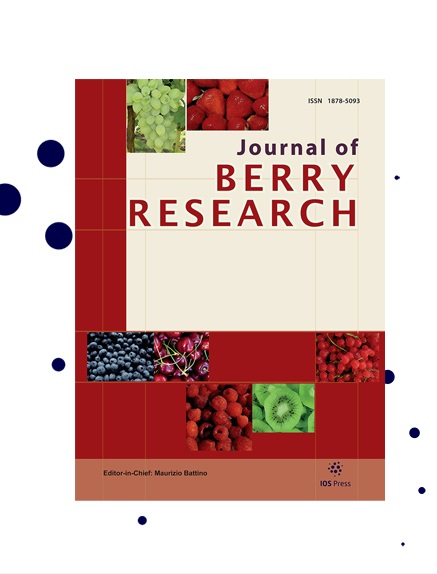ABA通过积极影响成熟相关基因表达和代谢物谱加速黑莓果实成熟
IF 1.4
4区 农林科学
Q3 PLANT SCIENCES
引用次数: 4
摘要
背景:黑莓果实的柔软性限制了其采后的保质期和商业用途,脱落酸(ABA)被认为是参与果实成熟的关键激素之一。目的:探讨ABA对黑莓果实成熟和软化的生理和分子作用。方法:同时测定处理和未处理黑莓果实的各项生理指标和植物激素水平。通过rna测序分析差异表达基因(DEGs),并检测其表达谱。结果:25 d后,ABA处理的果实ABA浓度、聚半乳糖醛酸酶(PG)和β -1,4-内切葡聚糖酶(EG)活性显著高于未处理的果实。与细胞壁软化和ABA合成相关的DEGs的表达主要在25或28 d后被触发。69种差异积累的代谢物最终被注释为与果实成熟有关。结论:ABA通过促进细胞壁酶活性、多种成熟相关基因表达和代谢物积累等途径促进黑莓果实成熟。本文章由计算机程序翻译,如有差异,请以英文原文为准。
ABA accelerates blackberry (Rubus spp.) fruit ripening by positively affecting ripening-related gene expression and metabolite profiles
BACKGROUND: The softness of blackberry fruits limits their postharvest shelf-life and commercial use, and abscisic acid (ABA) is considered one of the key hormones involved in fruit ripening. OBJECTIVE: This study aimed to explore the underlying physiological and molecular actions of ABA on blackberry fruit ripening and softening. METHODS: Various physiological indices of and plant hormone levels in treated and untreated blackberry fruits were determined simultaneously. The differentially expressed genes (DEGs) were analyzed by RNA-sequencing, and their expression profiles were detected. The ripening mechanism was elucidated by UHPLC-MS using two groups of fruits at 28 d. RESULTS: After 25 d, the ABA concentration and polygalacturonase (PG) and beta-1,4-endoglucanase (EG) activities in ABA-treated fruits were significantly higher than those in untreated fruits. Large differences in the expression profiles were detected at 28 d. The expression of DEGs related to cell wall softening and ABA synthesis was largely triggered after 25 or 28 d. Sixty-nine differentially accumulated metabolites were ultimately annotated as related to fruit ripening. CONCLUSIONS: ABA stimulates blackberry fruit ripening by promoting cell wall enzyme activities, the expression of various ripening-related genes and metabolite accumulation.
求助全文
通过发布文献求助,成功后即可免费获取论文全文。
去求助
来源期刊

Journal of Berry Research
Biochemistry, Genetics and Molecular Biology-Biochemistry
CiteScore
3.50
自引率
11.80%
发文量
21
期刊介绍:
The main objective of the Journal of Berry Research is to improve the knowledge about quality and production of berries to benefit health of the consumers and maintain profitable production using sustainable systems. The objective will be achieved by focusing on four main areas of research and development:
From genetics to variety evaluation
Nursery production systems and plant quality control
Plant physiology, biochemistry and molecular biology, as well as cultural management
Health for the consumer: components and factors affecting berries'' nutritional value
Specifically, the journal will cover berries (strawberry, raspberry, blackberry, blueberry, cranberry currants, etc.), as well as grapes and small soft fruit in general (e.g., kiwi fruit). It will publish research results covering all areas of plant breeding, including plant genetics, genomics, functional genomics, proteomics and metabolomics, plant physiology, plant pathology and plant development, as well as results dealing with the chemistry and biochemistry of bioactive compounds contained in such fruits and their possible role in human health. Contributions detailing possible pharmacological, medical or therapeutic use or dietary significance will be welcomed in addition to studies regarding biosafety issues of genetically modified plants.
 求助内容:
求助内容: 应助结果提醒方式:
应助结果提醒方式:


